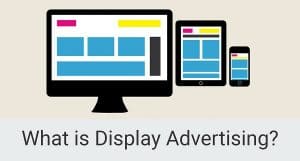When simple text ads don’t effectively express your marketing messages, you might consider turning to display advertising. Display advertising lets you quickly share information with your target audience, whether you’re promoting a seasonal sale or soliciting signups for your new eCourse.
Display advertising can be a great complement to your content, too, as long as you’re proactive and careful about your marketing campaigns and who you partner with for display ad purposes. Working with networks that allow sites to pepper pages with dozens of spammy-looking ads is rarely good for your brand, but well-placed, tasteful advertisements that incorporate branded content often work well to increase your exposure.
What is Display Advertising?
Display advertising refers to digital ads that incorporate one or more of the following:
- Short video clips
- Audio
- Photos or computer-designed graphics
- Flash media
- Text
Sometimes online video advertising (suggested link to online video guide here) is subtle, and the videos blend in with the rest of the site. That’s not the case with display advertising. Display ads aren’t necessarily in-your-face ads, but they aren’t designed to look like traditional content either. When you visit a website, it’s usually easy to identify the display ads. If you’ve ever built your own website using a template from WordPress or a similar host, you may have noticed rectangles where you can plug in your Adsense info. These slots are reserved for display advertising. They’re typically located at the top, bottom or side of each page, and they come in several sizes.
Sizes commonly used for display ads include:
- Leaderboard ads for desktop users, which measure 728 x 90 pixels
- Leaderboard ads for mobile users, which measure 320 x 50 pixels
- Inline rectangle ads, which measure 300 x 250 pixels
- Half-page ads, which measure 300 x 600 pixels
The size you choose depends on several factors, such as the layout of your website, the amount of information you want to share and the type of ad you create. For example, a display ad featuring a video clip probably won’t work well as a 728 x 90 leaderboard ad. The video might become distorted, and it will be hard for viewers to follow what’s happening. Think about the shape of a traditional television set or movie-theater screen, and mimic that when you create or share an ad with video content.
Types of Display Advertising
There are several different types of display advertising, which we’ll detail below. The type that’s best for you depends on the network and platform you choose for your ads.
Google Display Advertising
Google display advertising refers to advertisements launched through Google’s AdWords network. More than 650,000 apps and 2 million websites participate in the Google AdWords program, so you’re probably familiar with Google display advertising even if you’ve never personally used it.
The Huffington Post is one of Google’s biggest success stories when it comes to pay-per-click earnings. The company admits it isn’t generating an operational profit yet, but it’s banking approximately $170 million annually from Google display ads.
Google display ads for business owners
If you want to create your own display ads and have Google host them on relevant sites, start by signing up for AdWords. Once you’re registered, you can use the company’s ad gallery to quickly and easily create your own advertisements.
After you upload images and format text in the ad gallery, Google places your advertisements on relevant websites targeted toward your preferred demographics. There’s no guesswork involved; you let Google know exactly who you want to view your advertisements. Before your posts go live, Google AdWords has you set a specific budget so it knows how often to share your display ads.
Need help figuring out what to put in your display ads? Google AdWords offers a handy keyword planner that provides insight into trending search terms.
Google display ads for Adsense Affiliate
If you want to earn money from a website or app rather than promoting products or services, enroll in Google Adsense. It’s free to join, but Google doesn’t automatically approve every website. Your chances of approval increase if your site is family friendly (no gambling articles or pics of models wearing revealing clothing) and has value to its visitors. Basically, you can’t have two or three articles surrounded by 20 or 30 advertisements because Google considers that spammy.
Once you’re approved for an Adsense account, you receive a publisher ID. You can insert that ID in WordPress or Blogger templates, or you can build your own display ads using HTML. This ID helps track impressions and clicks, so Google knows how much to pay you. Google sends out payments once a month, and you qualify for a payment if your balance equals at least $100 when payments are verified. There’s a slight delay, so if you have $100 in mid-June, you won’t receive your funds until Google Adsense issues its end-of-July payment.
Worried the ads on your site won’t reflect topics that interest your readers? Use a keyword tool, such as Jaaxy or the AdWords keyword planner that we discussed earlier. Experts disagree about the exact percentage of keywords a website needs, so focus on naturally incorporating popular terms relevant to your niche each time you upload new content. Try to avoid off-topic rants when you post articles, as these may result in display ads that aren’t relevant to your niche.
Mobile Display Advertising
Mobile display advertising refers to ads that appear on mobile devices. Smartphones are a well-known mobile device, but companies also create ads that appear on tablets, iPods, eReaders, and netbooks.
King, which owns popular gaming apps like Candy Crush and Pet Rescue Saga, is currently working on developing a form of nonintrusive mobile advertising. This method is different than the approach typically used for mobile display advertising, which involves banner ads or in-line rectangle ads that appear above or below content.
You may have noticed these ads when you check the weather from your phone or access gaming apps. They are also found on news websites and sites that feature viral content, such as Upworthy.
As with Google display advertising, you can use Google AdWords to create and launch mobile display ads. The process is generally the same as the process for desktop ads. Alternately, you can enlist the help of companies like AppNexus or Millennial Media.
If you are a website owner who wants to ensure the ads you host are mobile friendly, check the settings for your site’s theme. Some themes or dashboards have a section dedicated to mobile compatibility that explains whether your site loads content correctly for users, not on desktops.
Programmatic Display Advertising
Programmatic display advertising involves showing targeted ads at the right time. We’ll talk more about targeted display advertising in a bit; until then, keep in mind that timing is crucial when you use programmatic display advertising.
Need facts to verify its importance? Programmatic display advertising influences approximately 2 out of 3 people who make a purchase after seeing a digital advertisement. It relies on detailed information about your target demographics to help influence them to purchase an item they were likely going to buy in the future.
Let’s say you sell pink shoes and a woman you’ve never interacted with wants to buy pink shoes. She’s never formally typed “buy pink shoes” in a search engine or visited your online shop, but she’s browsing wedding and fashion sites in a manner that mimics other ladies who own pink shoes. When your programmatic display ad appears while she’s browsing other sites, she clicks on it, sees your shoes and orders them.
You can also use programmatic display advertising to track the actions of regular visitors. This method evaluates tracking previous actions, such as buying electronics or viewing specific recipes, before developing a unique ad tailored toward each viewer. As with the other forms of display advertising we’ve discussed, you can use Google AdWords to execute programmatic advertising campaigns.
If you haven’t already, now is a good time to experiment with AdWords automated bidding. When you request automated bidding, AdWords analyzes previous data to determine when and where to show your ads. It understands the difference between seasonal trends and regular buying patterns, so you won’t end up displaying Christmas tree ads in March. This eliminates the need to constantly update your digital advertising process, freeing you up to focus on other marketing plans.
Targeted Display Advertising
Targeted display advertising is similar to programmatic display advertising because both approaches rely on information collected about the men and women who view your ads. The Google Display Network connects advertisers and websites, making it possible for them to create or launch targeted ads.
Some marketers mistakenly assume that targeted display advertising is just for large businesses. Targeted ads benefit companies of all sizes, from solopreneurs peddling eBooks to medium-sized candy shops. When you participate in the Google Display Network, you can set a budget that matches your goals or choose ads that complement your niche. You may have seen targeted ads after visiting Overstock.com or a similar site. After browsing for new jewelry or a decorative rug, ads with phrases such as “You might also like …” might appear on your screen. Amazon does something similar, and it also sends emails regarding products you’ve viewed recently, even if you never added them to your online shopping cart.
If you visit Facebook after shopping on Overstock.com, you might feel as if your shopping history is stalking you. Sandwiched between status updates and Buzzfeed quizzes are advertisements showcasing your recently viewed items, reminding you of what you could have — or should have — bought. Some marketers consider these advertisements a form of targeted display advertising, while others call them programmatic ads. Regardless of which term you prefer, these ads are a marketing approach known as remarketing.
Remarketing occurs when you attempt to bring people back to your website after they have visited it in the past. Targeted display advertising lets you do that, and you can target desktop or mobile users when you create a Google campaign.
Content from our partners
Display Advertising Networks
If you want to create or share digital ads, you have to connect with display advertising networks. The network you choose depends on how many customers or website visitors you have as well as your budget and advertising goals.
A whopping 92 percent of internet users see ads shared by Google’s Display Network. You can access this large chunk of the world if you join Google AdWords as an advertiser or Google Adsense as an affiliate. The Google Display Network is ideal for nearly every business. Customizable tools let you control how much you spend on your ads as well as who sees them and where they appear. If you’re a website owner who wants to earn money from ads shared by other companies, join Google Adsense. You can monitor the number of visitors who click or view your ads and view statistics about the viewers of your ads.
Media.net
If you’re a member of the blogging community, you may have noticed that many bloggers have switched from Adsense to Media.net. AuthorityIncome.com says that Media.net is “the best earning alternative to Adsense,” explaining that the site has brought in more than $90,000 from Media.net advertisements. The site is popular with niche website owners, such as food bloggers, travel writers, and business experts.
Globally, Media.net employs more than 800 workers. Google has nearly 62,000 employees, so you might prefer Media.net if you want to work with a smaller company. Reviews about Media.net praise its prompt, cordial responses and user-friendly platform.
Adblade
Google and Media.net do not require a specific number of page views per months, but Adblade only works with high-traffic websites. You must average at least 500,000 monthly page views to join the Adblade network as a publisher. Adblade is easier on advertisers; they only need a $50 deposit to launch a campaign. If you’re an advertiser, you can create your own ads or ask Adblade for assistance. Publishers do not have control over which ads they display, but the company states that marketing promotions featuring hate speech and other inappropriate topics are banned. You can join more than one display advertising network unless you’re under an exclusive contract with a specific company. Many marketers choose to participate in multiple networks so that they can determine which one is the best match for their needs.
Display Advertising Trends
Social media websites plan to dominate the display advertising scene by 2017. Experts expect Facebook and Twitter to claim approximately one-third of display advertising expenditures. That’s more than other big players in the marketing world, such as Amazon, Microsoft, and even Yahoo, are on schedule to receive. Advertisers are relying less on graphics and text, focusing instead on video clips. Expect to see the number of short video ads continue to increase in 2017 and beyond. As we mentioned earlier, companies like King are looking for ways to implement subtle digital advertising campaigns. Instead of large banner ads or in-text marketing, you might notice an increase in unintrusive display ads on your favorite gaming apps.
You don’t have to jump on digital advertising trends if they aren’t a good fit for your marketing skills or goals, and you should never launch display ads that aren’t in line with your overall content efforts. Experiment with different methods of display advertising until you find one that you like — but do it soon because your audience is waiting.












